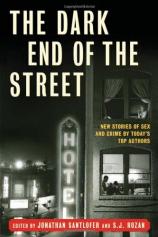Interview
Question: What made you decide to write this book?
Jonathan Santlofer: As two crime fiction writers who constantly hear disparaging remarks about crime fiction, we wanted to put Crime Fiction and Literary writers together in one book, have them all write about one subject --- sex --- and prove that a good story is a good story no matter who writes it.
S.J. Rozan: What he said. The disparaging remarks, by the way, are from critics and sometimes from readers --- never from writers of any ilk.
Q: How did you settle on the theme?
J.S.: We chose sex because it is universal and often controversial. We added the idea of crime, but noted that a crime could be whatever the writer thought constituted any sort of criminal behavior.
S.R.: We also said sex could be whatever the writer defined it as.
Q: THE DARK END OF THE STREET features a lot of different interpretations of the theme of sex and crime. Which one surprised you the most?
J.S.: Almost every story surprised us in some way. Lawrence Block’s story is particularly surprising because it begins as a traditional crime story, then shifts into a wonderfully conceptual commentary about crime fiction writing. Lee Child’s ending also surprises, as does Laura Lippman’s turn-the-tables revenge. But many of the stories linger in the mind and haunt, rather than surprise: the diabolic humor in Ed White; the cold cruelty of Jonathan Lethem’s killer; Amy Hempel’s unflinching look at adultery; Francine Prose’s wicked, often hilarious musing of beheadings; Lynn Freed’s savagery. But really every story was surprising and beautiful.
S.R.: I'm not sure I was surprised by anything, except how many people agreed to contribute. If I was, it wasn't by any one story, but by the hugely disparate range of emotions and moods. Bell's unspoken, tragic undercurrents were balanced the straightforward, analytical how-to decisions of McDermid's narrator; Lee's and McCabe's contributions were entirely different from each other in all but this: neither the sex nor the crime actually happens...probably...
Q: There are some really striking illustrations that help set the mood of the book. What was your inspiration in creating them? What effect were you looking to produce?
J.S.: I thought about, and looked at many things for inspiration --- film noir, the paintings of Edward Hopper, and I walked around the city at night making quick sketches of lone figures and people heading in and out of the subway. I wanted the drawings to evoke several, often disparate things: the distance between human beings, tenderness, sexuality, loneliness, drama…
S.R.: I thought I was your inspiration.
Q: If you had the chance to produce the sequel to this book, what would it be? What other writers would you approach?
J.S. & S.R.: We’d like to push the envelope even further, to have authors write stories about transgression, to create characters who do things they would never normally do, step out of their lives and take a crazy, daring chance. And we are compiling an amazing list of writers who will do just that.





